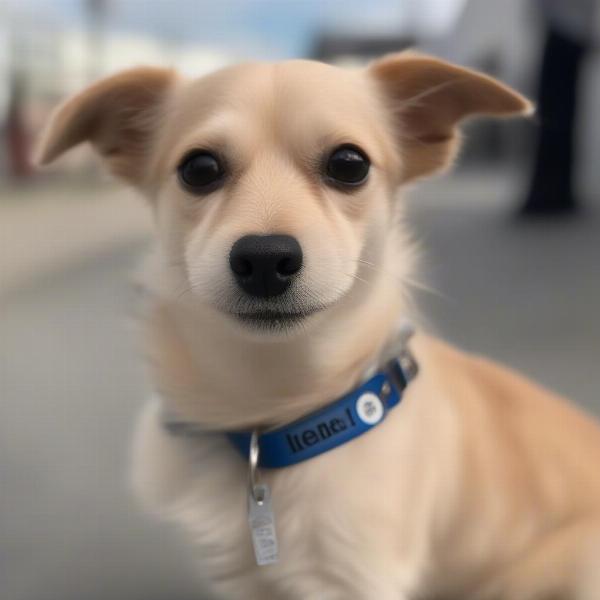Choosing the right collar for your small dog can be a daunting task. With so many options available, it’s important to understand what factors to consider, from size and material to safety and style. This guide will help you navigate the world of pet collars for small dogs, ensuring you find the perfect fit for your furry friend.
Finding the Perfect Fit: Sizing and Types of Collars for Small Breeds
When choosing a collar for your small dog, proper fit is crucial. A collar that’s too tight can restrict breathing, while one that’s too loose can easily slip off. Measure your dog’s neck with a flexible tape measure, leaving enough space for two fingers to fit comfortably between the collar and your dog’s neck.
There are several types of collars designed for small dogs, each with its own advantages and disadvantages:
- Standard Buckle Collars: These are the most common type, offering a simple and secure fastening mechanism. They come in various materials like nylon, leather, and fabric.
- Breakaway Collars: Designed for safety, these collars feature a quick-release mechanism that will break open if the collar gets caught on something, preventing choking hazards. This is a particularly good choice for playful puppies and small dogs who tend to explore.
- Martingale Collars: These collars tighten slightly when pulled, preventing escape artists from slipping out. However, they shouldn’t be used for continuous pulling and should never be left on unsupervised.
- Harnesses: While not technically collars, harnesses are a popular alternative for small dogs, especially those prone to tracheal collapse. They distribute pressure across the chest and back, reducing strain on the neck.
Material Matters: Choosing the Right Collar Material
The material of your dog’s collar impacts both comfort and durability. Here’s a breakdown of common collar materials:
- Nylon: Durable, affordable, and easy to clean, nylon collars are a popular choice. They come in a wide variety of colors and patterns.
- Leather: Stylish and comfortable, leather collars soften and mold to your dog’s neck over time. However, they require more care than nylon collars and can be more expensive.
- Biothane: This waterproof and odor-resistant material is a great option for active dogs who love to swim or get muddy. It’s also very durable and easy to clean.
Safety First: Essential Collar Considerations
Always ensure your dog’s collar has proper identification. A tag with your dog’s name, your phone number, and ideally, your address, is crucial in case your furry friend gets lost. Microchipping is another essential safety measure.
 Small dog collar with ID tag
Small dog collar with ID tag
Style and Functionality: Accessorizing Your Small Dog’s Collar
designer dog collar come in a wide array of designs, from simple and classic to trendy and personalized. You can also add accessories like charms, bandanas, and even bow ties to express your dog’s unique personality. However, make sure any additions are secure and don’t pose a choking hazard.
Training and Collars: Choosing the Right Tool for the Job
For training purposes, specialized collars like pet training collar for small dogs can be helpful. Always consult with a certified dog trainer before using any training collar, especially on small dogs, to ensure proper usage and avoid causing harm. Positive reinforcement methods are generally recommended for training small breeds.
Conclusion: The Perfect Collar for Your Perfect Companion
Choosing the right pet collar for your small dog involves careful consideration of size, material, safety, and style. By understanding the different options available and following the guidelines in this guide, you can find the perfect collar to keep your furry friend safe, comfortable, and looking their best. Remember to prioritize your dog’s comfort and safety above all else.
FAQ:
- How often should I check my small dog’s collar? Check your dog’s collar regularly, ideally daily, to ensure a proper fit and look for signs of wear and tear.
- Can I leave a collar on my small dog all the time? While some dogs can wear collars all the time, it’s generally recommended to remove the collar during unsupervised crate time or playtime to prevent accidents.
- What’s the best type of collar for a small dog that pulls on the leash? A harness or a martingale collar can be helpful for small dogs that pull, but consult with a trainer for guidance on proper usage and training techniques.
- How can I personalize my small dog’s collar? You can personalize your dog’s collar with ID tags, charms, and bandanas, but ensure they are secure and don’t pose a choking hazard.
- Are there any special considerations for puppies? Puppies grow quickly, so it’s essential to check their collar fit frequently and adjust it as needed. Breakaway collars are often a good choice for puppies.
- What should I do if my dog’s collar is causing skin irritation? Remove the collar immediately and try a different material. Consult your veterinarian if the irritation persists.
- Where can I find high-quality collars for small dogs? Reputable pet stores and online retailers offer a wide selection of high-quality collars for small dogs.
Related Articles:
About ILM Dog
ILM Dog is your comprehensive online resource for expert advice on dog care and nurturing. We offer practical guidance on various aspects of dog ownership, from choosing the right breed to health, training, nutrition, and grooming. Whether you’re a new dog owner or a seasoned expert, ILM Dog provides valuable insights and resources to help you provide the best possible care for your furry companion. Contact us at [email protected] or +44 20-3965-8624 for personalized assistance. We also offer a wide range of products and accessories to help you find the perfect diamond dogs shirt.